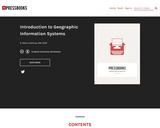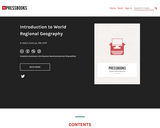The intent of this textbook is to update and build upon the body of knowledge that exists within the geographic discipline.
Chapter 1: Introduction to World Regional Geography
1.1 Geography as a Science
1.2 Location and Regions on Earth
1.3 Human Population and Culture
1.4 Globalization and Development
1.5 Careers in Geography
1.6 Summary
1.7 Attribution and References
Chapter 2: Europe
2.1 Physical Geography of the Region
2.2 History and Culture of the Region
2.3 Regions of Western Europe
2.4 Regions of Eastern Europe
2.5 Summary
2.6 Attributions and References
Chapter 3: Russia
3.1 Physical Geography of the Region
3.2 History and Culture of the Region
3.3 Regions of Russia
3.4 Summary
3.5 Attributions and References
Chapter 4: North America
4.1 Physical Geography of the Region
4.2 History and Culture of the Region
4.3 Regions of North America
4.4 Canada
4.5 United States of America
4.6 Summary
4.7 Attributions and References
Chapter 5: Middle America
5.1 Physical Geography of the Region
5.2 History and Culture of the Region
5.3 Mexico
5.4 Central America
5.5 The Caribbean
5.6: Summary
5.7 Attributions and References
Chapter 6: South America
6.1 Physical Geography of the Region
6.2 History and Culture of the Region
6.3 Urban North and Andean West
6.4 Brazil
6.5 The Southern Core
6.6 Summary
6.7 Attributions and References
Chapter 7: Subsaharan Africa
7.1 Physical Geography of the Region
7.2 History and Culture of the Region
7.3 West Africa
7.4 Central Africa
7.5 East Africa
7.6 Southern Africa
7.7 Attributions and References
Chapter 8: North Africa and Southwest Asia
8.1 Physical Geography of the Region
8.2 History and Culture of the Region
8.3 North Africa and the African Transition Zone
8.4 Israel and Its Neighbors
8.5 Arabian Peninsula
8.6 Iraq, Turkey, and Iran
8.7 Central Asia
8.8 Attributions and References
Chapter 9: South Asia
9.1 Peripheral States of South Asia
9.2 Pakistan and Bangladesh
9.3 India
9.4 Chapter Summary
9.5 Attributions and References
Chapter 10: East Asia
10.1 Physical Geography of the Region
10.2 History and Culture of the Region
10.3 China
10.4 China’s Periphery
10.5 Japan
10.6 North and South Korea
10.7 Attributions and References
Chapter 11: Southeast Asia
11.1 Physical Geography of the Region
11.2 History and Culture of the Region
11.3 Mainland Countries
11.4 The Insular Region
11.5 Chapter Summary
11.6 Attributions and References






